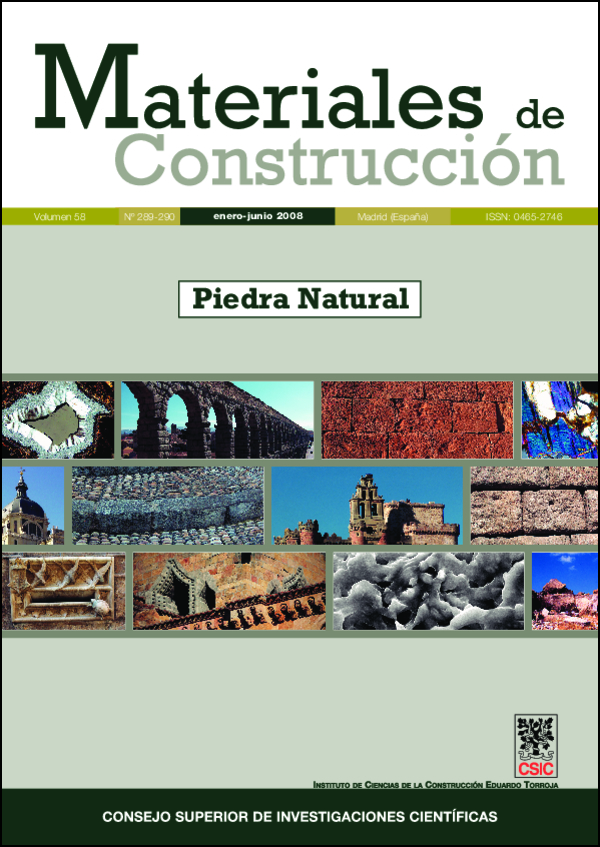Artificial weathering of granite
DOI:
https://doi.org/10.3989/mc.2008.v58.i289-290.80Keywords:
artificial weathering tests, salt crystallisation cycles, graniteAbstract
This article summarizes a series of artificial weathering tests run on granite designed to: simulate the action of weathering agents on buildings and identify the underlying mechanisms, determine the salt resistance of different types of rock; evaluate consolidation and water-repellent treatment durability; and confirm hypotheses about the origin of salts such as gypsum that are often found in granite buildings. Salt crystallization tests were also conducted, using sodium chloride, sodium sulphate, calcium sulphate and seawater solutions. One of these tests was conducted in a chamber specifically designed to simulate salt spray weathering and another in an SO2 chamber to ascertain whether granite is subject to sulphation. The test results are analyzed and discussed, along with the shortcomings of each type of trial as a method for simulating the decay observed in monuments. The effect of factors such as wet-dry conditions, type of saline solution and the position of the planes of weakness on the type of decay is also addressed.
Downloads
References
[1] J. Ordaz, R. Esbert. “Porosity and capillarity in some sandstones and dolomite monumental stones.” Proceed. V Int. Symp. On Deterioration and Conservation of Stone, Lausanne (1985), vol. 1, pp. 93-102.
[2] B.J. Smith, J.P. McGreevy. “Contour scaling of a sandstone by salt weathering under simulated hot desert conditions”. Earth Surface Processes and landforms, vol. 13, (1988), pp. 697-705. doi:10.1002/esp.3290130804
[3] L. Martín, M.A. Bello, A. Martín. “Accelerated alteration test on the stones used in Catedral of Granada (Spain).” Proceed. VII Int. Symp. On Deterioration and Conservation of Stone, Lisboa (1992), vol. 1, pp. 845-850.
[4] D.J. McMahon, P. Sandberg, K. Folliard, P.K. Mehta. “Deterioration mechanisms of sodium sulphate.” Proceed. VII Int. Symp. On Deterioration and Conservation of Stone, Lisboa (1992), vol. 2, pp. 705-714.
[5] L. Binda, G. Baronio, T. Squarcina. “Evaluation of the durability of bricks and stones and of conservation treatments”. Proceed. VII Intern. Symp. On Deterioration and Conservation of Stone, Lisboa (1992), vol. 2, pp. 753-762.
[6] C.M. Grossi, Cristalización de sales en rocas monumentales porosas y auscultación mediante emisión acústica. p. 261. Tesis doctoral. Dpto. Geología. Universidad de Oviedo, 1992.
[7] A. Pérez, J. Ordaz, R. Esbert, F.J. Alonso. “Microfissuring evolution of Axeitos granite along a crystallization test.” Proceed. II Intern. Symp. Conservation of Monuments in the Mediterranean Basin, Venecia (1994), pp 115-119.
[8] F.J. Alonso, R. Esbert, J. Ordaz. “Saline spray action on treated dolomitic stone”. Proceed. II Intern. Symp. Conservation of Monuments in the Mediterranean Basin, Venecia (1994), pp. 867-870.
[9] A.P. Ferreira, J. Delgado, D. Costa. “Behaviour of water repellents in granites under accelerated ageing test.” Proceed. II Int. Symp. Conservation of Monuments in the Mediterranean Basin, Venecia (1994), pp. 877-882.
[10] M. Casal, B. Silva, J. Delgado. “Agents and forms of weathering in granitic rocks used in monuments”. Proceed of European Symposium Science Technology and European Cultural Heritage, Bolonia, (1989), pp. 439-442.
[11] T. Rivas, Mecanismos de alteración de rocas graníticas utilizadas en la construcción de edificios antiguos de Galicia. p. 358, Servicio de Publicaciones e Intercambio Científico de la Univ. Santiago de Compostela, 1997.
[12] B. Silva, T. Rivas, B. Prieto. “Soluble Salts in Granitic Monuments: Origin and Decay Effects”. En: Applied Study of Cultural Heritage and Clays, (2003), pp. 113-131.
[13] J.M. Birginie, T. Rivas, B. Prieto, F. Auger. “Comparaison de l’altérabilité au brouillard salin de deux pierres calcaires de construction au moyen de mesures pondérales, acoustiques et par traitement d’images ». Mater. Construcc., vol. 50, nº 259, (2000), pp. 27-43
[14] T. Rivas, B. Prieto, B. Silva, J.M. Birginie. “Comparison between traditional and chamber accelerated ageing test on granitic rocks”. Proceed. 9th Intern. Congress on deterioration and Conservation of Stone, Venecia (2000), pp. 171-180.
[15] T. Rivas, J.M. Birginie, B. Prieto, F. Auger. “Granite decay by a marine salt-spray accelerated ageing test”. En: Protection and Conservation of the Cultural Heritage of the Mediterranean Cities. (2002), pp. 227-233
[16] C. Cardell, T. Rivas, M.J. Mosquera, B. Prieto, J.M. Birginie, B. Silva. A. Moropoulou, R. Van Grieken. “Patterns of damage in igneous and sedimentary rocks under conditions simulating sea-salt weathering”. Earth Surf. Process. Landforms, nº 28, (2003), pp. 1-14
[17] Reunion Internationale des Laboratoires d’Essais et de recherche sur les materiaux et les Constructions. (RILEM). “Crystallization test by total inmersion (Test V.1.) Crystallization test by partial inmersion (Test V.2.)”. Proceed. Intern. Symposium Deterioration and Conservation of Stone monuments. UNESCO-RILEM, Paris, (1978).
[18] T. Rivas, B. Prieto, B. Silva. “Influence of rift and bedding planes on the physico-mechanical properties of granitic rocks. Implications for the deterioration of granitic monuments”. Building and Environment nº35, (2000), pp. 387-396. doi:10.1016/S0360-1323(99)00037-2
[19] T. Rivas, B. Prieto, B. Silva. “Permeability to water vapour of granitic rocks: application to the study of deleterious effects of conservation treatments”. Building and Environment, nº 36, (2001), pp. 239-346 T. Rivas, B. Prieto, B. Silva doi:10.1016/S0360-1323(00)00003-2
[20] T. Rivas, B. Prieto, B. Silva. “The effect of crystallisation of Na2So4 and Na Cl on the weathering of various granites.” Proceed. 4 Intern. Symp. on the conservation of monuments in the Mediterranean Basin, Rhodes (1997), vol. 1, pp. 271-281
[21] T. Rivas, B. Prieto, B. Silva, J.M. Birginie. “Weathering of granitic rocks by chlorides: effects of the nature of the solution on weathering morphology”. Earth Surf. Process. Landforms, nº 28, (2003), pp. 425-436
[22] T. Rivas, B. Prieto, B. Silva. “Gypsum formation in granitic rocks by dry deposition of sulphur dioxide.” Proceed. 4 Intern. Symp. on the conservation of monuments in the Mediterranean Basin, Rhodes (1997), vol. 1, pp. 263-270.
[23] T. Rivas, B. Silva, B. Prieto. “Medida de la durabilidad de dos tratamientos de hidrofugación aplicados a rocas graníticas”. Mater. Construcc., Vol. 48, nº250 (1998), pp. 5-14.
[24] B. Silva, T. Rivas, B. Prieto. “Tratamientos de consolidación e hidrofugación aplicados en sustratos graníticos húmedos y contaminados por sales”. Mater. Construcc., Vol. 50, nº 257, (2000), pp. 15-31.
Downloads
Published
How to Cite
Issue
Section
License
Copyright (c) 2008 Consejo Superior de Investigaciones Científicas (CSIC)

This work is licensed under a Creative Commons Attribution 4.0 International License.
© CSIC. Manuscripts published in both the print and online versions of this journal are the property of the Consejo Superior de Investigaciones Científicas, and quoting this source is a requirement for any partial or full reproduction.
All contents of this electronic edition, except where otherwise noted, are distributed under a Creative Commons Attribution 4.0 International (CC BY 4.0) licence. You may read the basic information and the legal text of the licence. The indication of the CC BY 4.0 licence must be expressly stated in this way when necessary.
Self-archiving in repositories, personal webpages or similar, of any version other than the final version of the work produced by the publisher, is not allowed.
















